-
Posts
3,562 -
Joined
-
Last visited
-
Days Won
22

GeeBee replied to Rick Junkin's topic in Miscellaneous Aviation Talk

GeeBee replied to dkkim73's topic in General Mooney Talk

GeeBee replied to FlyingScot's topic in Modern Mooney Discussion

GeeBee replied to FlyingScot's topic in Modern Mooney Discussion

GeeBee replied to FlyingScot's topic in Modern Mooney Discussion

GeeBee replied to Steve Dawson's topic in Modern Mooney Discussion

GeeBee replied to redbaron1982's topic in General Mooney Talk

GeeBee replied to redbaron1982's topic in General Mooney Talk

GeeBee replied to Rick Junkin's topic in Miscellaneous Aviation Talk

GeeBee replied to Rick Junkin's topic in Miscellaneous Aviation Talk

GeeBee replied to dkkim73's topic in Modern Mooney Discussion

GeeBee replied to Marc_B's topic in Modern Mooney Discussion

GeeBee replied to dkkim73's topic in Modern Mooney Discussion

GeeBee replied to GeeBee's topic in Modern Mooney Discussion
We have placed cookies on your device to help make this website better. You can adjust your cookie settings, otherwise we'll assume you're okay to continue.